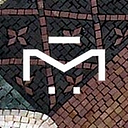The undeniable influence of the ancient Egyptian mosaic art
Ancient Egypt is famous for its unique approach to artistic expression. From glorious predynastic images inscribed on rock walls to beautifully morbid ritualistic art surrounding the dead, Egyptians were and still are immensely valuable to the cultural heritage of the human race.
One of the main strengths of Egyptian art was versatility. Egyptians used a wide array of different materials to express their stands and beliefs through their art. Their search for new and contrasting materials lead them to faraway countries and continents, so some significant import was inevitable. One of the most famous examples of their usage of imported materials is lapis lazuli — a luminous blue stone that originated from the territory of what is today Afghanistan.
The technique of mosaic making that mosaicists use to this day originated in ancient Egypt. Considering the fact that Egyptian artists were known for their versatility with materials, this comes as no surprise. The nature of mosaic art allows its artists to use almost any type of material that comes to mind. From lapis lazuli to wood, metals, and native stones such as the ubiquitous limestone, calcite, and schist, Egyptian mosaicists used a huge variety of materials to make their mosaics long-lasting, intricate and gorgeous.
Egyptians were the first to use tesserae to compose a mosaic picture. Initially, they used simple fragments of various materials in different colors, but they later progressed to coloring the tesserae with pigments and decorating them with gold and precious stones. However, the ancient Egyptians didn’t just stick to what was known and easily accessible when it comes to mosaic-making materials. During the late Hellenistic period, Egyptians started creating the first mosaic glass plates. These glorious pieces of artistic expression exemplify some of the most sophisticated glassmaking techniques in ancient history.
Mosaic art found its purpose in almost every part of ancient Egypt. From decorating the simplest objects such as glasses and vases to decorating pharaoh’s thrones and whole villas and palaces, mosaic art had quickly spread to the surrounding territories as well. During that most famous period of Egyptian history known as the New Kingdom of Egypt (c. 1570 — c. 1069 BCE), all of the royals and nobility, as well as other wealthy families used mosaic artwork to embellish their homes and places of worship.
One of the most well-preserved examples of the versatility and skill of the ancient Egyptian mosaicists is most definitely the Villa of the Birds in Alexandria, Egypt. Thousands of art and history buffs from around the world come to this lovely port city to admire its glorious mosaic images every year. Mosaic decorating the villa depict parrots, peacocks, pigeons, quail and water hens, and a variety of other animals, featuring a wide range of decorative techniques from the imperial era.
The whole of ancient Egyptian society was based on the unique concept of ma’at, or harmony, which is what sustains the universe itself. All Egyptian art is based on the perfection of balance because it reflects the world of gods. So if you were ever wondering about the beauty and worth of mosaic artwork, just remember that the Egyptian artists created mosaic making while trying to reflect the very world of their gods and goddesses. Beat that oil, canvas, and aquarelle! Hmpf.
